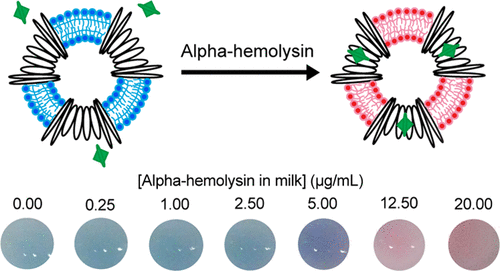当前位置:
X-MOL 学术
›
ACS Appl. Polym. Mater.
›
论文详情
Our official English website, www.x-mol.net, welcomes your
feedback! (Note: you will need to create a separate account there.)
Polydiacetylene for the Detection of α-Hemolysin in Milk toward the Diagnosis of Bovine Mastitis
ACS Applied Polymer Materials ( IF 4.4 ) Pub Date : 2020-09-18 , DOI: 10.1021/acsapm.0c00968 Max Weston 1 , Mustafa Ciftci 1, 2, 3 , Rhiannon P. Kuchel 4 , Cyrille Boyer 1, 2 , Rona Chandrawati 1
ACS Applied Polymer Materials ( IF 4.4 ) Pub Date : 2020-09-18 , DOI: 10.1021/acsapm.0c00968 Max Weston 1 , Mustafa Ciftci 1, 2, 3 , Rhiannon P. Kuchel 4 , Cyrille Boyer 1, 2 , Rona Chandrawati 1
Affiliation

|
Early diagnosis of mastitis is essential to reduce the expenses it imparts on the dairy industry. Existing techniques fail to provide rapid and pathogen-specific information to direct the prescription of antibiotics. Polydiacetylene (PDA)-based colorimetric sensors have emerged as promising bacterial screening tools that show potential for application in the diagnosis of bacterial infections. However, there are challenges in operating PDA sensors in complex samples, as identified in our recent work. To overcome this challenge, herein, we design and synthesize a custom diacetylene monomer via a copper-catalyzed cross-coupling reaction to yield 6,8-tricosadiynoic acid. Photopolymerization of 6,8-tricosadiynoic acid monomers yields blue-phase PDA with superior chromatic stability to milk constituents and reduced chromatic response to temperature fluctuations, which diminish the likelihood of false positives. We then form functionalized PDA vesicles by insertion of 1,2-dimyristoyl-sn-glycero-3-phosphocholine phospholipid and cholesterol in the PDA membrane. This allows the detection of α-hemolysin, a hemolytic toxin excreted by Staphylococcus aureus, a predominant causative pathogen of bovine mastitis. We demonstrate the detection of α-hemolysin in phosphate-buffered saline (limit of detection (LOD) = 3.62 μg/mL) and milk samples (LOD = 6.62 μg/mL) by a blue to red color change visible to the naked eye. The color change is studied by absorption spectroscopy and digital colorimetric analysis of photographs. We attribute the color change to pore formation in the PDA membrane and lysis of the vesicles due to the action of the S. aureus α-hemolysin. This is evidenced by vesicle membrane destruction in transmission electron microscopy micrographs of PDA vesicles before and after incubation with the toxin. The specificity of the sensor is demonstrated by discrimination between α-hemolysin and other toxins and biomarkers for mastitis. This is the first custom-designed PDA for point-of-care application in bovine milk samples and the first documented detection of α-hemolysin using a PDA-based sensor.
中文翻译:

聚二乙炔检测牛乳中的α-溶血素对牛乳腺炎的诊断
乳腺炎的早期诊断对于减少乳制品业的支出至关重要。现有技术无法提供快速且特定于病原体的信息来指导抗生素的处方。基于聚二乙炔(PDA)的比色传感器已成为有前途的细菌筛选工具,显示出在细菌感染诊断中的应用潜力。但是,在我们最近的工作中发现,在复杂样品中操作PDA传感器存在挑战。为了克服这一挑战,本文中,我们通过铜催化的交叉偶联反应设计并合成了定制的二乙炔单体,从而生成6,8-三异丁二酸。6的光聚合 8-triosadiynoic酸单体产生的蓝相PDA对牛奶成分具有出色的色彩稳定性,并减少了对温度波动的色彩响应,从而减少了假阳性的可能性。然后,我们通过插入1,2-二肉豆蔻酰-形成功能化的PDA囊泡PDA膜中的sn -glycero-3-phosphocholine磷脂和胆固醇。这样可以检测到α-溶血素,这是一种由金黄色葡萄球菌(一种牛乳腺炎的致病性致病菌)分泌的溶血毒素。我们证明了肉眼可见的蓝到红颜色变化检测到磷酸盐缓冲液(检测限(LOD)= 3.62μg/ mL)和牛奶样品(LOD = 6.62μg/ mL)中的α-溶血素。通过吸收光谱法和照片的数字比色分析研究颜色变化。由于金黄色葡萄球菌的作用,我们将颜色变化归因于PDA膜中的孔形成和囊泡的溶解α-溶血素。这可以通过与毒素孵育前后的PDA囊泡的透射电子显微镜照片中的囊泡膜破坏来证明。通过区分α-溶血素和其他毒素以及乳腺炎的生物标志物可以证明传感器的特异性。这是第一个为牛乳样品提供即时医疗服务的定制设计PDA,也是第一个使用基于PDA的传感器对α-溶血素进行检测的文献记录。
更新日期:2020-11-13
中文翻译:

聚二乙炔检测牛乳中的α-溶血素对牛乳腺炎的诊断
乳腺炎的早期诊断对于减少乳制品业的支出至关重要。现有技术无法提供快速且特定于病原体的信息来指导抗生素的处方。基于聚二乙炔(PDA)的比色传感器已成为有前途的细菌筛选工具,显示出在细菌感染诊断中的应用潜力。但是,在我们最近的工作中发现,在复杂样品中操作PDA传感器存在挑战。为了克服这一挑战,本文中,我们通过铜催化的交叉偶联反应设计并合成了定制的二乙炔单体,从而生成6,8-三异丁二酸。6的光聚合 8-triosadiynoic酸单体产生的蓝相PDA对牛奶成分具有出色的色彩稳定性,并减少了对温度波动的色彩响应,从而减少了假阳性的可能性。然后,我们通过插入1,2-二肉豆蔻酰-形成功能化的PDA囊泡PDA膜中的sn -glycero-3-phosphocholine磷脂和胆固醇。这样可以检测到α-溶血素,这是一种由金黄色葡萄球菌(一种牛乳腺炎的致病性致病菌)分泌的溶血毒素。我们证明了肉眼可见的蓝到红颜色变化检测到磷酸盐缓冲液(检测限(LOD)= 3.62μg/ mL)和牛奶样品(LOD = 6.62μg/ mL)中的α-溶血素。通过吸收光谱法和照片的数字比色分析研究颜色变化。由于金黄色葡萄球菌的作用,我们将颜色变化归因于PDA膜中的孔形成和囊泡的溶解α-溶血素。这可以通过与毒素孵育前后的PDA囊泡的透射电子显微镜照片中的囊泡膜破坏来证明。通过区分α-溶血素和其他毒素以及乳腺炎的生物标志物可以证明传感器的特异性。这是第一个为牛乳样品提供即时医疗服务的定制设计PDA,也是第一个使用基于PDA的传感器对α-溶血素进行检测的文献记录。











































 京公网安备 11010802027423号
京公网安备 11010802027423号